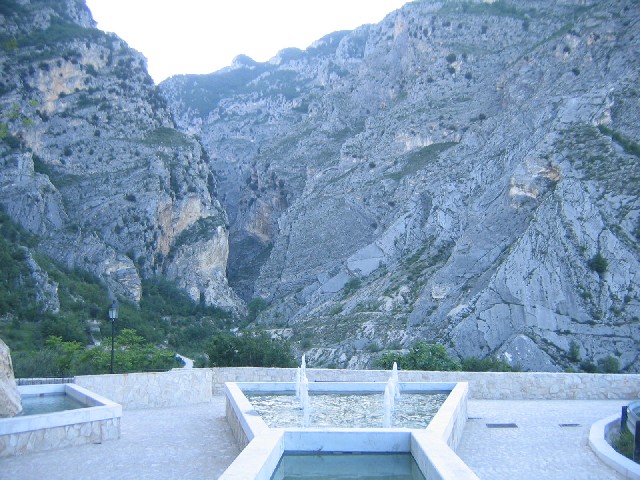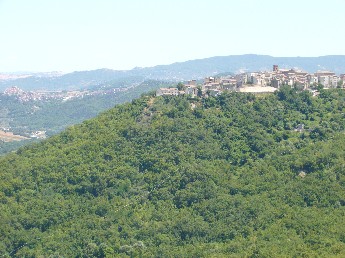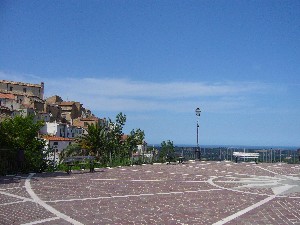Villages and Towns
In Abruzzo there are a lot of fortified ancient villages, testifying to an adventurous past and all villages have a spectacular views to discover natural delights like waterfalls and springs.
Abruzzo is not only the region of the nature, but also a place of religion , art and history. Numerous are the rocky churches such as the hermitage of Grotte Sant-Angelo at Palombaro or abbeys of various style such as S. Giovanni in Venere near Lanciano.
The memories of the ancient Abruzzo are still alive in town dating back to the Roman times such as Juvanum.
Following we suggest some town and city to visit during your holiday:
Lanciano
Lanciano is a very beautiful mediaeval small city which dates back to 1098 B.C. Lanciano still maintains its unique character and warmth as a typical real Italian city. The city is based on rolling hills which steadily grow higher as you head towards to the mountain. In Lanciano there are a wide range of shops, restaurants, coffee bars and modern amenities such as swimming pools, bowling alleys, shopping centres, bingo theatres, football stadium, etc. There are also some unique historical and architectural buildings and churches and there is a world famous Eucharistic miracle housed in Lanciano.
San Vito
San Vito is beautifully sited sea side resort, 360 degree view of mountains and sea front.
The historical centre of the village is characteristic with its old buildings of different ages.
Since the development of the coastal railway in 1864 , S.Vito beach developed along the coast. Today it is a famous and frequented bathing location.
Along the coast as far as Vasto, it is possible to admire the "trabocchi", old stilt-constructions suspended above the sea for fishing. The poet Gabriele D-annunzio called these constructions: colossal -spiders-. The same poet lived here in a quiet house (l-ermo) with Barbara Leoni drawing his inspiration for the famous Trionfo della morte.
In Vallev˛, just outside San Vito, there is the home of the Documentation Centre on Trabocchi, where guided tours of the Trabocchi can be arranged.
Fine sand beaches are interspersed with wild cliffs and tiny bays with crystal-clear and fish filled water, ideal for scuba diving and for those who prefer nature to social events and night life- which however, are never too far way in the cities and towns.
Regarding public transport, in 2006 a new rail link was created between Pescara and Vasto, which passes San Vito.
Ortona
Famous for its history and for the monuments that either survived the last war (The Cathedral of S.Tommaso and the Castle of Aragonese), Ortona is also one of the best-loved resorts on the Chieti coast. The commercial port, the most important in Abruzzo, can been seen from the Passeggiata Orientale, an impressive scenic road where on one side you can see green countryside and the town, and on the other there are wide curved sandy beaches (Lido Riccio and Lido Saraceni) but also rocky stretches and amazing inlets, ideal for canoeing.
Ortona has pubs, restaurants, shopping and spectacular sea views.
Regarding public transport, in 2006 a new rail link was created between Pescara and Vasto, which passes Ortona.
Fossacesia
Fossacesia is situated in the Gulf of Venere. It appears as a perfect blend of blue Adriatic sea and green olive and vine clad hills. North of the beach is the rocky coast of Punta Cavaluccio, with the distinctive Trabocchi can be seen, ideal for canoeing. The town is split, like many coastal towns, into two parts - the lido or beach resort and the original old town on a hill above the lido. Slightly inland, therefore, you can pay a visit to Fossacesia in the hills, and the Cistercian Abbey of S.Giovanni in Venere. Also, about 2 Km from the Val di Sangro exit on the A14 there is the new -Marina del sole- Harbour.
Regarding public transport, in 2006 a new rail link was created between Pescara and Vasto, which passes Fossacesia on the coast
Civitella Messer Raimondo
Civitella Messer Raimondo is a Mediaeval village perched on top of a hill at the foot of the Majella overlooking Fara San Martino.
The discovery of the archaeological finds and of mosaic flooring of the Roman age, testifies a continuity of settlements in this village. The first written testaments date back to the XII century. At at center of this village is a castle named after the Baglioni-s family.
In Civitella besides having a wonderful view and a beautiful landscape there are a lot of little firms that sell local products (oil, meat, processed and cold meats, mushrooms, honey..) and it is possible to see some craftsmen that sculpt - the white Majella stone-.
Not far from Civitella there are Fara San Martino (Pasta valley with picnic site), Lama Dei Peligni (picnic areas and swinmming pool), Cavallone-s cave (grottos at the end of a cable car trip), lake Sant-Angelo (or Casoli - great for fishing) and Palena (only 15 minutes away and the nearest ski resort).
Casoli
Casoli is located on a hill on the right-hand side of the Aventino river. It dominates the river below which feeds into the beautiful lake Sant-Angelo (or Casoli) and the surrounding hills.
Casoli is a mediaeval village where today it-s possible to visit the large castle and its walls and the churches which were built between 1417 and 1587 like S.Rocco and S. Reparata
Moreover in Casoli you can visit a WWF natural reserve, which is home to the great white heron, the black stork and the flamingo.
Fara San Martino
Fara San Martino is one of the Italian capitals of pasta production. A village at the foot of the eastern slope of the Majella. Since ancient times, the presence of the extra-pure mountain water (Verde River) has been used to create -the best pasta- which is now exported all over the world.
Around the village there are a lot of caves that once were a refuge for shepherds and brigands. Fara San Martino is located inside the Majella National Park where it is possible to see deer, bears, chamois (mountain goats) and golden eagles?

Bomba
Bomba is a hill village of Chieti province and it is a tourist location for both its artistic beauty and for the landscape. The village is famous for the presence of the Bomba Lake. The excursions in the surrounding woods and in Pallano Mountain are spectacular also because there are the wall ruins that justified a human presence before roman age. There are two local camp sites with swimming pools, and night life and where you can do various water sports and other land activities. You can also hire chalets, there are restaurants and cycle tracks.
Silvio and Bertrando Spaventa were both born in Bomba.
Gessopalena
Gessopalena dates back to ancient times; the numerous ruins found in the countryside belonged to the pre-Roman and Roman periods, testify their presence. It was an important defensive center. The castle had a strategic position that dominated the Aventino river valley and blocked the entrance onto the Maiella. The first historically certain information goes back to the 12th century. During the 15th century Gessopalena was possessed by the Caldora family from Vasto. From the 16th century to the 18th century the Capua family controlled this village, afterwards the Caracciolo family, from San Buono, dominated. During World War II Gessopalena was completely destroyed.
The village preserves an old tradition: the representation of Christ-s Passion, it plays every holy Wednesday and the Procession crosses also the old village.
Palombaro
Palombaro is a village with a beautiful view of the Avello valley.
It has roman origin but the first written testaments date back to the XII century.
Near the village there is the striking S.Angelo Cave that inside preserves the ruins of amediaeval church.
Very interesting to visit is The S.Assunta church with its gothic bell tower from the eighteenth century and the natural reserve Feudo Ugni.
Not far from Palombaro there are Fara San Martino (Pasta valley with picnic site), Lama Dei Peligni (picnic areas and swimming pool), Cavallone-s cave (grottos at the end of a cable car trip), Civitella Messer raimondo and lake Sant-Angelo (or Casoli - great for fishing) and Palena (only 15 minutes away and the nearest ski resort).

Torino di Sangro
One of the quietest resorts on the Chieti coast, Torino di Sangro Marina is located east of the Mouth of Sangro river. The town is split, like many coastal towns, into two parts - the lido or beach resort and the original old town on a hill above the lido.
The beaches are some of the cleanest in the area, Le Morge and Torino Di Sangro beaches are well organised and have both sandy and pebbled areas.
The main town is 9 Km inland and can be reached by a climbing road where the vegetation changes from typically Mediterranean land to a wonderful ilex wood (also home to a natural reserve - the Bitopo delle Leccette Litoranee- and various camp sites). The 16th century parish church of S.Salvatore is a main attraction. The Bitopo delle Leccette Litoranee was set up in 1979 and covers 180 hectares of land. It contains durmast and turkey oaks, as well as oriental hornbeams, helms, ilexes. The wildlife includes passerines and small mammals. Regarding public transport, in 2006 a new rail link was created between Pescara and Vasto, which passes Torino di Sangro on the coast

Lama dei Peligni
Lama dei Peligni situated just below -Monte Amaro- (highest point of the Majella mountain), comprises in its territory the Natural Oasi of the eastern Majella, and is a starting point for many beautiful hiking excursions, horseback and biking itineraries. Inhabited since pre-historic times, in the XII century it was, with nearby Palena, Taranta Peligna e Lettopalena, one of the key defence points along the way to Chieti on the Southwestern Valvense direction.
To Visit
Church of San Nicola (XVI century), with Baroque furnishings
Grottos di Sant'Angelo, which has been a religious destination for centuries
Grotto del Cavallone, famous for its beautiful concretions and for being a background for some of the scenes in D'Annunzio's "Festa di Iorio"
Majella National Park
Naturalistic Museum
Outdoor swimming pool
Picnic area in pine forests and near natrural springs
Useful numbers and information for Abruzzo (Download)